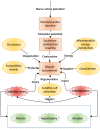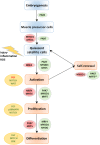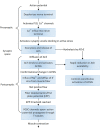Skeletal muscle: A review of molecular structure and function, in health and disease
- PMID: 31407867
- PMCID: PMC6916202
- DOI: 10.1002/wsbm.1462
Skeletal muscle: A review of molecular structure and function, in health and disease
Abstract
Decades of research in skeletal muscle physiology have provided multiscale insights into the structural and functional complexity of this important anatomical tissue, designed to accomplish the task of generating contraction, force and movement. Skeletal muscle can be viewed as a biomechanical device with various interacting components including the autonomic nerves for impulse transmission, vasculature for efficient oxygenation, and embedded regulatory and metabolic machinery for maintaining cellular homeostasis. The "omics" revolution has propelled a new era in muscle research, allowing us to discern minute details of molecular cross-talk required for effective coordination between the myriad interacting components for efficient muscle function. The objective of this review is to provide a systems-level, comprehensive mapping the molecular mechanisms underlying skeletal muscle structure and function, in health and disease. We begin this review with a focus on molecular mechanisms underlying muscle tissue development (myogenesis), with an emphasis on satellite cells and muscle regeneration. We next review the molecular structure and mechanisms underlying the many structural components of the muscle: neuromuscular junction, sarcomere, cytoskeleton, extracellular matrix, and vasculature surrounding muscle. We highlight aberrant molecular mechanisms and their possible clinical or pathophysiological relevance. We particularly emphasize the impact of environmental stressors (inflammation and oxidative stress) in contributing to muscle pathophysiology including atrophy, hypertrophy, and fibrosis. This article is categorized under: Physiology > Mammalian Physiology in Health and Disease Developmental Biology > Developmental Processes in Health and Disease Models of Systems Properties and Processes > Cellular Models.
Keywords: molecular mechanisms; molecular structure; muscle health and disease; muscle physiology; skeletal muscle.
© 2019 The Authors. WIREs Systems Biology and Medicine published by Wiley Periodicals, Inc.
Conflict of interest statement
The authors have declared no conflicts of interest for this article.
Figures
















References
FURTHER READING
References
-
- Abou‐Khalil, R. , Mounier, R. , & Chazaud, B. (2010). Regulation of myogenic stem cell behaviour by vessel cells: The "ménage à trois" of satellite cells, periendothelial cells and endothelial cells. Cell Cycle, 9(5), 892–896. - PubMed
-
- Alabi, A. A. , & Tsien, R. W. (2013). Perspectives on kiss‐and‐run: Role in exocytosis, endocytosis, and neurotransmission. Annual Review of Physiology, 75, 393–422. - PubMed
Publication types
MeSH terms
Grants and funding
- U19 AI090023/NH/NIH HHS/United States
- U01 DK097430/DK/NIDDK NIH HHS/United States
- R01 HL106579/HL/NHLBI NIH HHS/United States
- R01 HD084633/NH/NIH HHS/United States
- R01 LM012595/LM/NLM NIH HHS/United States
- U2C DK119886/NH/NIH HHS/United States
- R01 DK109365/NH/NIH HHS/United States
- U2C DK119886/DK/NIDDK NIH HHS/United States
- U01 CA198941/NH/NIH HHS/United States
- U01 CA200147/CA/NCI NIH HHS/United States
- U01 CA198941/CA/NCI NIH HHS/United States
- U19 AI090023/AI/NIAID NIH HHS/United States
- R01 HL108735/HL/NHLBI NIH HHS/United States
- R01 LM012595/NH/NIH HHS/United States
- U01 CA200147/NH/NIH HHS/United States
- U01 DK097430/NH/NIH HHS/United States
- R01 DK109365/DK/NIDDK NIH HHS/United States
- R01 HD084633/HD/NICHD NIH HHS/United States
- R01 HL106579/NH/NIH HHS/United States
LinkOut - more resources
Full Text Sources
Other Literature Sources
Medical

